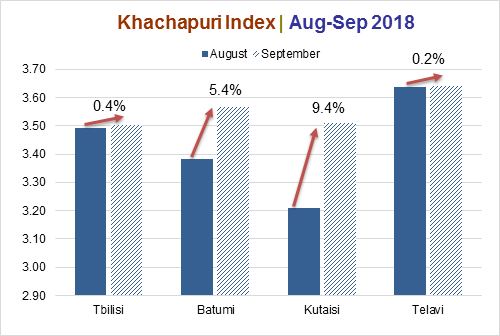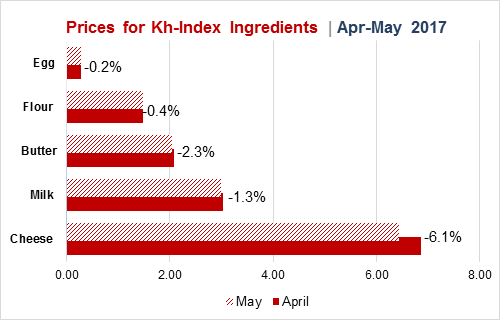- Details
In September 2018, the Khachapuri Index showed an upward seasonal trend, reaching 3.56 GEL. This is a 3.7% increase over the previous month (August 2018), but is 2.1% lower compared to September 2017 (y/y). Such an increase in prices at this time of year is not unique to the Khachapuri Index. The index is up due to the seasonal decline in the supply of milk and cheese (the main and most expensive khachapuri ingredient), with the supply of fresh milk falling from its peak of May/June.
The average cost of cooking one standard Imeretian khachapuri increased in all major Georgian cities. The price of khachapuri varied across Georgian cities ranging from 3.50 GEL, the minimum observed in Tbilisi, to 3.64 GEL, the maximum observed in Telavi. The high prices of khachapuri can be easily explained by the fact that it is currently Rtveli (harvest) season in Kakheti. Rtveli celebrations start at the end of August and continue until the middle of October. Over this period, Kakheti is very attractive for tourists.
- Details
In August 2018, the average cost of cooking one standard Imeretian khachapuri increased to 3.43 GEL, which is 3.8 % higher month-on-month (m/m, that is, compared to July 2018), but 0.5% lower year-on-year (y/y, compared to August 2017).
According to Khachapuri Index data, the price of wheat flour in different bazaars in Georgia has started to go up. The price of wheat rose by 1.6% in August month-on-month (compared to July 2018).
This increase follows a similar increase in the international market for this commodity. According to the FAO Food Price Index, the price of wheat has gone up by 8% month-on-month. High global prices of wheat this year have been attributed to a low supply in the world market. This will eventually be reflected in domestic wheat prices in Georgia, where the self-sufficient ratio for wheat is 15% and the country heavily depends on wheat imports. Almost 100% of wheat imports come from Russia. It is expected that higher wheat prices in the world market will be transmitted to Georgia in the coming months, leading to further increases in the price of wheat and wheat products. According to ISET’s policy paper “Price Transmission on the Wheat Flour Market in Georgia,” it takes around 6 months for international wheat prices to be transmitted fully into the domestic market.
- Details
The average cost of cooking one standard Imeretian Khachapuri in June 2018 stood at 3.15 GEL, which is 0.7% lower month-on-month (compared to the previous month), and 2% higher year-on-year (compared to the same month of last year).
The main contributors to the m/m Khachapuri Index deflation were cheese (down 0.6%) and flour (down 1.1%). The Kh-Index fell in all Georgian cities. At 3.27 GEL, Telavi saw the largest drop in the Index (-1.4%). Tbilisi (3.29 GEL) and Batumi (3.27 GEL) experienced declines of 0.4 % and 0.2%, respectively. Kutaisi was the cheapest city at 2.87 GEL (down by 0.8%). The price difference between the most expensive (Tbilisi) and the cheapest (Kutaisi) city reached 0.42 GEL.
- Details
In May 2018, the average price of cooking one Imeretian khachapuri stood at 3.17 GEL. Compared to the previous month (April 2018) the Khachapuri Index lost 3.6%. In annual terms (compared to May 2017), however, the Index added 0.9%.
The monthly (negative) change in the Index follows the traditional seasonal trend in fresh milk production, which peaks in June and July. Practically all khachapuri ingredients went down in price compared to last month: cheese (-6.1%), eggs (-0.2%), milk (-1.3%), butter (-2.3%) and flour (-0.4%).














